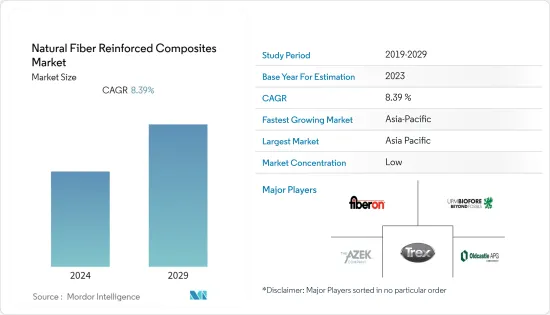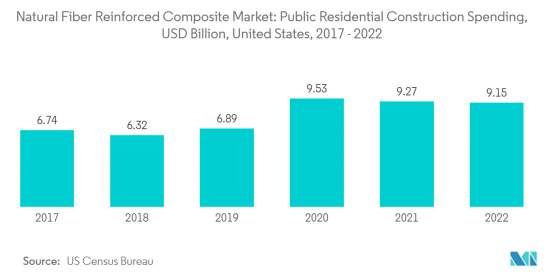 |
市場調查報告書
商品編碼
1403978
天然纖維增強複合材料:市場佔有率分析、產業趨勢與統計、2024-2029 年成長預測Natural Fiber Reinforced Composites - Market Share Analysis, Industry Trends & Statistics, Growth Forecasts 2024 - 2029 |
||||||
價格
※ 本網頁內容可能與最新版本有所差異。詳細情況請與我們聯繫。
簡介目錄
天然纖維增強複合材料市場預計將從2024年的4,081.05千噸成長到2029年的6,104.85千噸,預測期內複合年成長率為8.39%。

主要亮點
- 從中期來看,生物基複合材料需求的增加以及電子產業對環保複合材料需求的增加等因素將推動天然纖維增強複合材料市場的發展。
- 然而,吸濕性、有限的加工溫度、與大多數聚合物基體的不相容性以及與玻璃纖維增強複合材料相比較低的抗衝擊性可能是市場的抑制因素。
- 然而,天然纖維增強聚合物複合材料的阻燃性能有望為市場帶來新的機會。
- 亞太地區在市場中佔據主導地位,並且可能在預測期內實現最高的複合年成長率。這一成長歸因於建築業支出的迅速增加。
天然纖維增強複合材料市場趨勢
建築業的需求增加
- 建材業始終需要環保材料。基於天然纖維增強聚合物的複合材料由於其許多優點而擴大用於土木工程和建築應用。
- 複合材料在建設產業中發揮著至關重要的作用。工業柱、儲槽、大跨距屋頂結構、儲槽、高層建築、輕質門、窗、家具、輕質建築、橋樑構件、成套橋樑系統均採用複合材料。作為實現長期永續性的手段,複合材料在建設產業中變得越來越重要。
- 近年來,建築業得到了大量投資。根據牛津經濟研究院預測,2020 年至 2030 年間,全球建築業預計將成長 4.5 兆美元(42%),達到 15.2 兆美元。此外,2020年至2030年,中國、印度、美國和印尼預計將佔全球建設業成長的58.3%。
- 在北美,美國在建設產業中佔有很大佔有率。除美國外,加拿大和墨西哥也是建築業投資的主要貢獻者。美國人口普查局資料顯示,2022年美國公共住宅年金額為91.5億美元,較2017年的67.4億美元成長35.7%。
- 同樣,由於歐盟復甦基金的新投資,2022 年歐洲建築業成長了 2.5%。儘管大多數歐盟建設公司面臨價格壓力,但景氣預計將在 2022 年初恢復並達到 COVID-19 之前的水平。此外,隨著 COVID-19 危機的緩解,建築商將不願意投資新建築或維修現有房產。
- 因此,預計上述趨勢將在預測期內影響建築領域天然纖維增強複合材料的成長。

亞太地區主導市場
- 預計亞太地區將主導全球市場。中國、印度和日本等國家建設活動的增加正在增加該地區天然纖維增強複合材料的使用。
- 建築業是中國經濟持續發展的主要動力。根據中國國家統計局的數據,建築業產值將從2021年的29.3兆元(4.2兆美元)增加至2022年的31.2兆元(4.5兆美元)。預計到 2030 年,中國將在建築方面花費近 13 兆美元,這使得天然纖維增強複合材料的前景一片光明。
- 據住宅及城鄉建設部預計,2025年,中國建築業佔GDP的比重預計將維持在6%。根據這項預測,中國政府於 2022 年 1 月宣布了一項五年計劃,重點是使建築業更加永續和以品質主導。
- 同樣,天然纖維增強複合材料在電子產業的應用迅速增加也可能支持該國的工業成長。根據印度品牌股權基金會(IBEF)預測,到2025年,印度電子製造業的產值預計將達到5,200億美元。
- 此外,汽車是天然纖維增強複合材料的主要消費者之一。印度汽車工業在技術進步和宏觀經濟擴張中發揮關鍵作用,使其成為印度經濟表現的重要指標。
- 此外,印度政府也宣布加快(混合和)電動車的採用和製造,目標是到 2030 年實現 30%的電動車(EV)普及。透過我們的計劃,我們正在創造動力來鼓勵和一些地區強制要求,採用電動車。該計劃將為電動車創造需求獎勵,並支持在城市中心部署充電技術和充電站。政府設定的目標是,2030年,印度銷售的70%商用車、30%私家車、40%公車以及80%兩輪和三輪車為電動車。
- 因此,預計各國政府的新政策和投資將在預測期內提振亞太地區其他天然纖維增強複合材料市場的需求。
天然纖維增強複合材料產業概況
天然纖維增強複合材料市場分散,沒有一家公司佔據重要的市場佔有率。市場主要企業(排名不分先後)包括 Trex Company Inc.、Fiberon Technologies Inc.、UPM-Kymmene Oyj、The AZEK Company、Oldcastle APG 等。
其他福利:
- Excel 格式的市場預測 (ME) 表
- 3 個月的分析師支持
目錄
第1章簡介
- 調查先決條件
- 調查範圍
第2章調查方法
第3章執行摘要
第4章市場動態
- 促進因素
- 對生物基複合材料的需求增加
- 全球汽車工業的成長
- 抑制因素
- 吸濕性、加工溫度限制、與大多數聚合物基質的不相容性
- 由於暴露於外部環境而導致的劣化問題
- 產業價值鏈分析
- 波特五力分析
- 供應商的議價能力
- 消費者議價能力
- 新進入者的威脅
- 替代品的威脅
- 競爭程度
第5章市場區隔(基於數量的市場規模)
- 纖維
- 木纖維複合材料
- 非木纖維複合材料
- 棉布
- 亞麻
- 紅麻
- 麻
- 其他非木纖維複合材料
- 聚合物
- 熱固性樹脂
- 熱塑性塑膠
- 聚乙烯
- 聚丙烯
- PVC
- 其他熱塑性塑膠
- 最終用戶產業
- 航太
- 車
- 建築/施工
- 電力/電子
- 運動的
- 其他最終用戶產業
- 地區
- 亞太地區
- 中國
- 印度
- 日本
- 韓國
- 其他亞太地區
- 北美洲
- 美國
- 加拿大
- 墨西哥
- 歐洲
- 德國
- 英國
- 義大利
- 法國
- 歐洲其他地區
- 南美洲
- 巴西
- 阿根廷
- 南美洲其他地區
- 中東/非洲
- 沙烏地阿拉伯
- 南非
- 其他中東/非洲
- 亞太地區
第6章競爭形勢
- 併購、合資、聯盟、協議
- 市場佔有率排名分析
- 主要企業策略
- 公司簡介
- Amorim Cork Composites SA
- Fiberon Technologies Inc.
- FlexForm Technologies
- Green Dot Bioplastics Inc.
- GreenGran BN
- Jelu-Werk Josef Ehrler GmbH & Co. Kg
- Meshlin Composites ZRT
- NPSP NV
- Oldcastle APG
- Polyvlies Franz Beyer GmbH & Co. Kg
- Tecnaro GmbH
- The AZEK Company
- Trex Company Inc.
- TTS
- UPM-Kymmene Oyj
第7章 市場機會及未來趨勢
- 在建設產業中越來越受歡迎
簡介目錄
Product Code: 54642

The natural fiber reinforced composites market is expected to grow from 4,081.05 kilo tons in 2024 to 6,104.85 kilo tons by 2029, registering a CAGR of 8.39% during the forecast period.
Key Highlights
- Over the medium term, factors such as the increasing demand for bio-based composites and the growing demand for eco-friendly composites in the electronics industry would drive the natural fiber-reinforced composites market.
- However, the moisture adsorption, restricted processing temperature, incompatibility with most polymer matrices, and lower impact resistivity compared to glass fiber-reinforced composites are likely to act as restraints for the market.
- Nevertheless, the flame retardancy of natural fiber-reinforced polymer composites is expected to provide new opportunities for the market.
- The Asia-Pacific region dominates the market and is likely to witness the highest CAGR during the forecast period. This growth is attributed to the rapid rise in expenditure on the construction industry.
Natural Fiber Reinforced Composites Market Trends
Increasing Demand from the Construction Sector
- There is always a continuous requirement for eco-friendly materials in the building materials industry. Natural fiber-reinforced polymer-based composites are increasingly used in civil engineering construction applications due to their numerous advantages.
- In the building and construction industry, composite materials are extremely significant. Industrial supports, tanks, long-span roof structures, tanks, high-rise buildings and lightweight doors, windows, furnishings, lightweight buildings, bridge components, and complete bridge systems have all employed composite materials. Composite materials are becoming increasingly essential in the construction industry as a means of achieving long-term sustainability.
- The construction sector has witnessed major investments in recent years. According to Oxford Economics, the global construction industry is expected to grow by USD 4.5 trillion, or 42%, between 2020 and 2030 to reach USD 15.2 trillion. Also, China, India, the United States, and Indonesia are expected to account for 58.3% of global growth in construction between 2020 and 2030.
- In North America, the United States has a major share in the construction industry. Besides the United States, Canada and Mexico contribute significantly to investments in the construction sector. According to the United States Census Bureau Data, the annual value of public residential construction in the United States was valued at USD 9.15 billion in 2022, an increase of 35.7% compared to USD 6.74 billion in 2017.
- Similarly, the European construction sector grew by 2.5% in 2022 due to new investments from the EU Recovery Fund. Business confidence picked up in early 2022, despite price pressures at most EU construction firms, and is expected to reach pre-COVID-19 levels. Moreover, as the crisis due to COVID-19 abates, builders become less reluctant to invest in new corporate buildings and renovate existing properties.
- Hence, the aforementioned trends are projected to influence the growth of natural fiber-reinforced composites in the construction sector over the forecast period.

Asia-Pacific Region to Dominate the Market
- The Asia-Pacific region is expected to dominate the global market. With growing construction activities in countries such as China, India, and Japan, the usage of natural fiber-reinforced composites is increasing in the region.
- The construction sector is a key player in China's continued economic development. According to the National Bureau of Statistics of China, the value of construction output accounted for CNY 31.2 trillion (USD 4.5 trillion) in 2022, up from CNY 29.3 trillion (USD 4.2 trillion) in 2021. China is expected to spend nearly USD 13 trillion on buildings by 2030, creating a positive outlook for natural fiber-reinforced composites.
- As per the Ministry of Housing and Urban-Rural Development, China's construction sector is expected to maintain a 6% share of the country's GDP going into 2025. Keeping in view the given forecasts, the Chinese government unveiled a five-year plan in January 2022 focused on making the construction sector more sustainable and quality-driven.
- Similarly, the surging application of natural fiber-reinforced composites in the electronics industry is likely to support the industry growth in the country. According to the India Brand Equity Foundation (IBEF), the Indian electronics manufacturing industry is expected to reach USD 520 billion by 2025.
- Furthermore, automotive is among the major consumers of natural fiber-reinforced composites. The automotive industry in India is an important indicator of the Indian economic performance, as this sector plays a vital role in both technological advancements and macroeconomic expansion.
- Additionally, the Indian government has created momentum through its Faster Adoption and Manufacturing of (Hybrid and) Electric Vehicles schemes that encourage, and in some segments, mandate the adoption of electric vehicles (EV), intending to reach 30% EV penetration by 2030. The scheme creates demand incentives for EVs and supports the deployment of charging technologies and stations in urban centers. The government has set a target of 70% of all commercial cars, 30% of private cars, 40% of buses, and 80% of two-wheelers and three-wheelers sold in India by 2030 to be electric.
- Hence, the new policies and investments made by different governments are expected to boost the demand for the natural fiber-reinforced composites market in the rest of Asia-Pacific during the forecast period.
Natural Fiber Reinforced Composites Industry Overview
The natural fiber-reinforced composites market is fragmented, with no player capturing a significant market share. The major players in the market (in no particular order) include Trex Company Inc., Fiberon Technologies Inc., UPM-Kymmene Oyj, The AZEK Company, and Oldcastle APG, among others.
Additional Benefits:
- The market estimate (ME) sheet in Excel format
- 3 months of analyst support
TABLE OF CONTENTS
1 INTRODUCTION
- 1.1 Study Assumptions
- 1.2 Scope of the Study
2 RESEARCH METHODOLOGY
3 EXECUTIVE SUMMARY
4 MARKET DYNAMICS
- 4.1 Drivers
- 4.1.1 Increasing Demand for Bio-based Composites
- 4.1.2 Growth in Automotive Industry Worldwide
- 4.2 Restraints
- 4.2.1 Moisture Adsorption, Restricted Processing Temperature, and Incompatibility with Most Polymer Matrices
- 4.2.2 Degradation Issue Due to Exposure to the External Environment
- 4.3 Industry Value Chain Analysis
- 4.4 Porter's Five Forces Analysis
- 4.4.1 Bargaining Power of Suppliers
- 4.4.2 Bargaining Power of Consumers
- 4.4.3 Threat of New Entrants
- 4.4.4 Threat of Substitute Products and Services
- 4.4.5 Degree of Competition
5 MARKET SEGMENTATION (Market Size by Volume)
- 5.1 Fiber
- 5.1.1 Wood Fiber Composites
- 5.1.2 Non-wood Fiber Composites
- 5.1.2.1 Cotton
- 5.1.2.2 Flax
- 5.1.2.3 Kenaf
- 5.1.2.4 Hemp
- 5.1.2.5 Other Non-wood Fiber Composites
- 5.2 Polymer
- 5.2.1 Thermosets
- 5.2.2 Thermoplastics
- 5.2.2.1 Polyethylene
- 5.2.2.2 Polypropylene
- 5.2.2.3 Poly Vinyl Chloride
- 5.2.2.4 Other Thermoplastics
- 5.3 End-user Industry
- 5.3.1 Aerospace
- 5.3.2 Automotive
- 5.3.3 Building and Construction
- 5.3.4 Electrical and Electronics
- 5.3.5 Sports
- 5.3.6 Other End-user Industries
- 5.4 Geography
- 5.4.1 Asia-Pacific
- 5.4.1.1 China
- 5.4.1.2 India
- 5.4.1.3 Japan
- 5.4.1.4 South Korea
- 5.4.1.5 Rest of Asia-Pacific
- 5.4.2 North America
- 5.4.2.1 United States
- 5.4.2.2 Canada
- 5.4.2.3 Mexico
- 5.4.3 Europe
- 5.4.3.1 Germany
- 5.4.3.2 United Kingdom
- 5.4.3.3 Italy
- 5.4.3.4 France
- 5.4.3.5 Rest of Europe
- 5.4.4 South America
- 5.4.4.1 Brazil
- 5.4.4.2 Argentina
- 5.4.4.3 Rest of South America
- 5.4.5 Middle East and Africa
- 5.4.5.1 Saudi Arabia
- 5.4.5.2 South Africa
- 5.4.5.3 Rest of Middle East and Africa
- 5.4.1 Asia-Pacific
6 COMPETITIVE LANDSCAPE
- 6.1 Mergers and Acquisitions, Joint Ventures, Collaborations, and Agreements
- 6.2 Market Share Ranking Analysis
- 6.3 Strategies Adopted by Leading Players
- 6.4 Company Profiles
- 6.4.1 Amorim Cork Composites SA
- 6.4.2 Fiberon Technologies Inc.
- 6.4.3 FlexForm Technologies
- 6.4.4 Green Dot Bioplastics Inc.
- 6.4.5 GreenGran BN
- 6.4.6 Jelu-Werk Josef Ehrler GmbH & Co. Kg
- 6.4.7 Meshlin Composites ZRT
- 6.4.8 NPSP NV
- 6.4.9 Oldcastle APG
- 6.4.10 Polyvlies Franz Beyer GmbH & Co. Kg
- 6.4.11 Tecnaro GmbH
- 6.4.12 The AZEK Company
- 6.4.13 Trex Company Inc.
- 6.4.14 TTS
- 6.4.15 UPM-Kymmene Oyj
7 MARKET OPPORTUNITIES AND FUTURE TRENDS
- 7.1 Increasing Popularity in the Building and Construction Industry
02-2729-4219
+886-2-2729-4219













